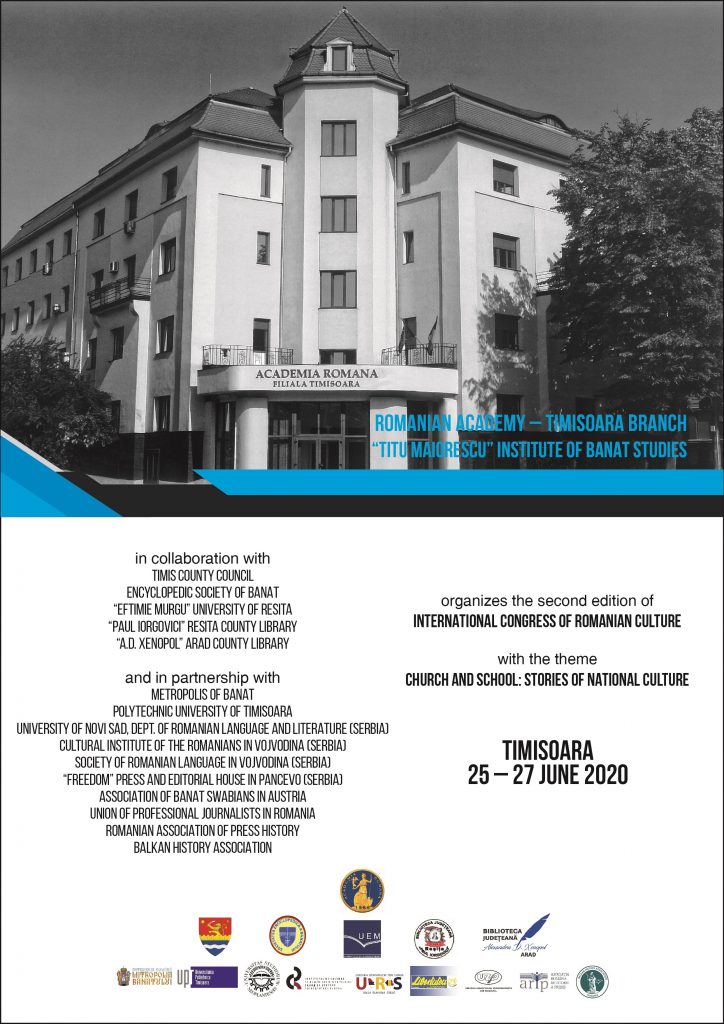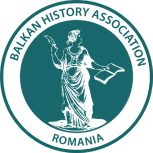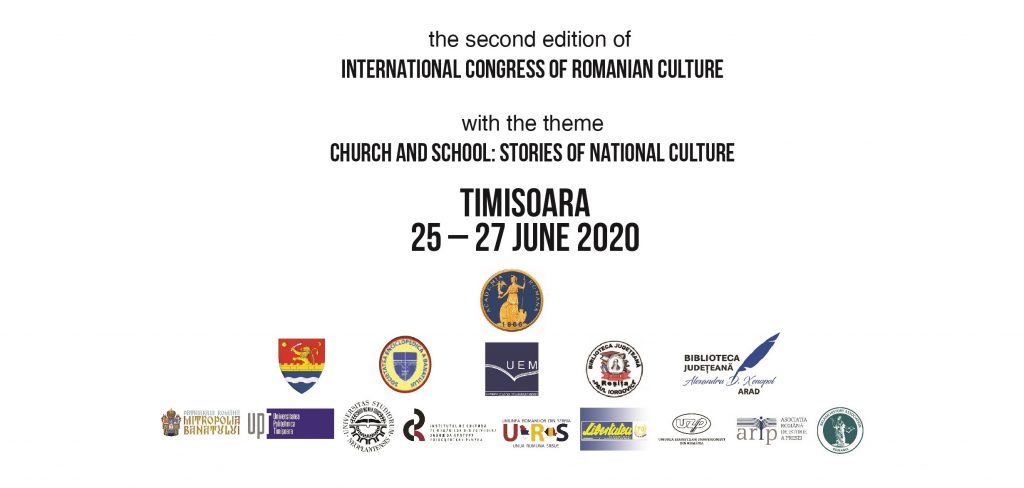ROMANIAN ACADEMY – TIMISOARA BRANCH
“TITU MAIORESCU” INSTITUTE OF BANAT STUDIES
in collaboration with
TIMIS COUNTY COUNCIL
ENCYCLOPEDIC SOCIETY OF BANAT
“EFTIMIE MURGU” UNIVERSITY OF RESITA
“PAUL IORGOVICI” RESITA COUNTY LIBRARY
“A.D. XENOPOL” ARAD COUNTY LIBRARY
and in partnership with
METROPOLIS OF BANAT
POLYTECHNIC UNIVERSITY OF TIMISOARA
UNIVERSITY OF NOVI SAD, DEPARTMENT OF ROMANIAN LANGUAGE AND LITERATURE (SERBIA)
CULTURAL INSTITUTE OF THE ROMANIANS IN VOJVODINA (SERBIA)
SOCIETY OF ROMANIAN LANGUAGE IN VOJVODINA (SERBIA)
“FREEDOM” PRESS AND EDITORIAL HOUSE IN PANCEVO (SERBIA)
ASSOCIATION OF BANAT SWABIANS IN AUSTRIA
UNION OF PROFESSIONAL JOURNALISTS IN ROMANIA
ROMANIAN ASSOCIATION OF PRESS HISTORY
BALKAN HISTORY ASSOCIATION
organizes the second edition of
INTERNATIONAL CONGRESS OF ROMANIAN CULTURE
with the theme
CHURCH AND SCHOOL: STORIES OF NATIONAL CULTURE
TIMISOARA
25 – 27 JUNE 2020
Subject areas
- Stages in the history of education
- Dual education in the face of the real economy
- Theological education: past, present and perspectives
- The role of Church and School in achieving the Great Union
- Orthodox priests in the Romanian countryside, pillars of local communities
- Monasteries, sources of spirituality
- The image of Church and School reflected in the media, literature and historiography
- Traditions of religious art
- School and Church publication: past, present and future
- Churches and schools in the Romanian diaspora
Conditions of participation and preliminary information
A registration form containing title and abstract of the communication in electronic format (MS Word, Times New Roman, 12 pp / 1.5 r., between 300 and 500 words) and a short CV (narrative) should be sent to the e-mail address: davidpressprint@gmail.com. The deadline for registration is April 5, 2020. The decision on acceptance (reached by a process of peer review) will be announced by April 10, 2020. The congress will take place in plenary sessions and in panel sections. Each communication is allocated 20 minutes. The congress volume will appear under the aegis of the Romanian Academy Publishing House and will be made available to the authors at the beginning of the congress. In this regard, we request that the full text of the communications be sent to: ioandavidtm@gmail.com by May 10, 2020.
Participation fees
– 100 lei: includes the presentation folder, the congress volume (The Anthology of the History of Romanian education in Banat), lunch and dinner (without accommodation);
– 150 lei: includes the presentation folder, the congress volume , meals, and documentary excursion to Caras-Severin (without accommodation);
– 200 lei: includes the presentation folder, the congress volume, meals, accommodation, and documentary excursion to Caras-Severin (Resita – “Eftimie Murgu” University and the “Paul Iorgovici” County Library; “Eftimie Murgu” village – The mill complex from Rudăria/Water mills/UNESCO Heritage; Bigar Waterfall).
Payment should be made to the account of the Encyclopedic Society of Banat RO22RZBR0000060014221846 at Raiffeisen Bank Timisoara (mentioning “Congress” 2020).
AUTHOR GUIDELINES
The following minimum editorial conditions are required: MS Word, Times New Roman, 12 pp / 1.5 r, maximum 10 pages, jpg images will be inserted in the text.
| Persons who do not comply with the rules below will not have their work published! |
STRUCTURE OF THE ARTICLE
1. the title, 2. the author’s name, 3. keywords (Romanian), 4. the actual text (with footnotes on each page), 5. references, 6. the abstract (the title, keywords and the summary in the foreign language, if the text was written in Romanian).
TITLE in bold capitals. It is advisable to refer as explicitly as possible to the content of the text and have a reasonable length. If it consists of or contains a quotation, this should be placed between quotation marks.
AUTHOR’S NAME on the line below the title, full right, bold upright (12 pt), spelt as in the language of the article.
KEYWORDS 5 or 6 words from the main text, indicating for its content. They can be common nouns or proper names not appearing in the title. They are to be in italic.
TEXT in 12pt, 1½ line spaced, in Romanian or in a language of international circulation (English, French, German).
THE BIBLIOGRAPHIC REFERENCES are to be included in the text, using the author–date system (Popescu 2004, p. 18); the notes are to be footnotes, numbered continuously throughout the text.
REFERENCES should be in 10 pt. They should comprise the author’s name, in bold , followed by the publication-year of the cited work and its identifiers: first and last name of the author(s), title (italic), subtitle (if applicable), place of publication, andpublisher.. If it is a chapter in a collective volume, the chapter-title will be followed by the full reference of the collective volume and the page-extent of the chapter. In the case of an article, the identifiers are: the author’s name (s), the title of the article (italic), the title of the journal (roman quoted), the volume-number (in Roman numerals), the year (in Arabic numerals), the issue- number, preceded by the abbreviation “nr.”, and the page-extent of the article (preceded by the abbreviation “p.”).
Examples
Popescu 2004 = Ion D. Popescu, Implicaţiile sociale ale artei. Studii, Bucureşti, Viceversa Publishing House
Popescu 2001 = Ion D. Popescu, Viitorul artei, in Georgescu 2001, p. 38-56
Popescu 2002 = Ion D. Popescu, Progresul în artă, „Revista de istorie a artei”, V, 2002, nr. 4, p. 2-3
Georgescu 2001 = Constantin Georgescu, Contribuţii teoretice la studiul diacronic al artelor, Cluj-Napoca, Compas
These short titles will be included in the text as a subject (Popescu 2001, p. 49 states that …) or object (for details, cf. Popescu 2001, p. 137) etc.
ABSTRACT (in a language of international currency, if the article is written in Romanian, and vice versa) to have the following components (all in 10 pt):
The title (which must exactly translate the title of the article), centred, in bold capitals. Under the title, add, in parentheses, in roman: Rezumat, Abstract, Résume, Zusammenfassung, etc
Keywords (bold), followed by examples (italic).
The abstract itself will not normally exceed 20 lines.


